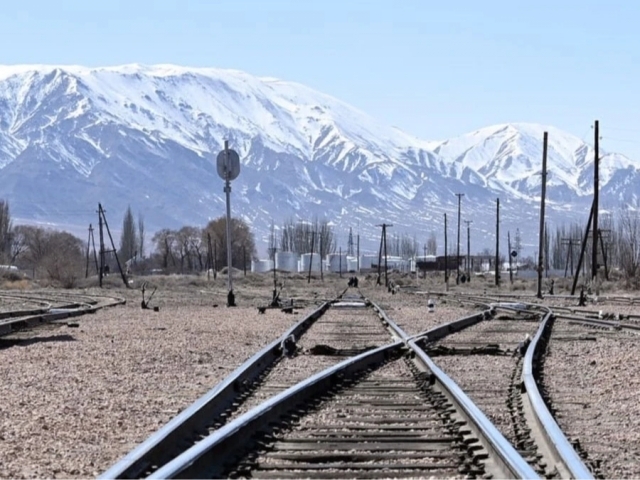Is momentum slipping from the China-Kyrgyzstan-Uzbekistan railway project once more?
Review
−
04 May 9526
The initiative for the China-Kyrgyzstan-Uzbekistan railway was conceived in 1997. Despite agreements reached between China and five Central Asian nations in May 2023, the project's commencement remains elusive. Initially set to kick off in a few months, the construction of the 523-kilometer route is yet to materialize. Professor Robert Cutler, the Central Eurasian Studies Society's founder, discussed the project's delay, Uzbekistan's involvement, and its potential benefits in an article published by "The Times of Central Asia."
Reasons for delay in railway construction
The article highlights disagreements over the route and, more significantly, funding risks that threaten to revert the project back to the stalled plans of over twenty-five years.
Following an initial accord in 1997, persistent disputes over funding and routing within Kyrgyzstan hindered negotiations, with a final agreement on construction terms only reached in the early 2000s.
“The disparities revolve around the geo-economic strategies of the involved parties, which have remained consistent for two decades. China prioritizes a shorter route, whereas Kyrgyzstan aims for a longer one to enhance its domestic infrastructure. Specifically, Kyrgyzstan seeks to utilize the railway construction to improve connectivity between its northern and southern regions, currently divided by a mountain range,” the report stated.
For Uzbekistan, the pivotal moment came in 2017 when it dispatched railway experts to engage in discussions with Kyrgyzstan about the project. Subsequently, in 2019, Uzbekistan proposed to co-finance Turkey's Kyrgyz branch. The projected cost of the entire venture stands at $6 billion. An initial agreement was brokered to distribute this sum, with each of the three parties committing to cover 30 percent, albeit at different stages of the initiative.
Reports indicate that public apprehensions in Kyrgyzstan regarding various practical issues persistently overshadow the final agreement.
These concerns encompass the anticipated influx of Chinese laborers, the need to enhance the skills of local railway engineers, investment in industrial endeavors along the railway corridor, and facilitating increased exports of Kyrgyz goods to the Chinese market.
"These factors are essential for ensuring the sustained effectiveness and prosperity of the China-Kyrgyzstan-Uzbekistan railway initiative," Cutler emphasizes.
Interestingly, these concerns closely mirror those of Kazakhstan, which caused delays in the construction of the initial phase (Atasu-Alashankou) of the Kazakhstan-China oil export pipeline in the early 2000s.
Moreover, China initially sought compensation from Bishkek for its involvement in Kyrgyzstan's mines, which include ownership of the world's second-largest iron ore reserves at Jetim Too, valued by Kyrgyz President Sadir Japarov at a minimum of $50 billion.
The proximity of this area to large glaciers underscores its vital role in supplying water for Kyrgyzstan's extensive agricultural activities.
Uzbekistan's efforts in bridging infrastructure gaps
During the November 1, 2023 meeting of the Shanghai Cooperation Organization (SCO) in Tashkent, transport officials from Uzbekistan, Kyrgyzstan, and Russia signed a memorandum to establish a new trade corridor between Kyrgyzstan and Russia, passing through Turkmenistan.
The proposed corridor entails transporting cargo from Turkmenbashi port in Turkmenistan to Astrakhan port in Russia via the Caspian Sea.
While Turkmen officials have participated in discussions, Ashkhobot has yet to confirm its involvement in the corridor.
This route offers an alternative to the usual Kyrgyzstan-Russia paths, which often experience lengthy border crossings into Kazakhstan.
Preliminary details suggest a modest scale for the project, with Russia initially providing 50 to 60 vehicles daily for transportation between Turkmenbashi and Astrakhan.
In subsequent phases, semi-trailers would be loaded onto boats in Turkmenbashi, transporting Kyrgyz goods to Astrakhan for unloading and reloading.
Further stages involve container transportation to the Russian port of Makhachqal’a. Turkmenistan has proposed adjustments to these plans, indicating that effective multimodal logistics solutions are still under development in the country.
Another memorandum involving Uzbekistan was concurrently signed to propose expanding the International “North-South” Trade Corridor (INCTC) alongside a new corridor.
The envisioned route spans Belarus, Russia, Kazakhstan, Uzbekistan, Afghanistan, and Pakistan, involving SCO members except for Afghanistan and Belarus, which hold observer status.
Despite their absence from SCO events, the Taliban have not sent representatives since assuming power in August 2021.
Similar to the proposed Kyrgyz-Uzbekistan-Turkmenistan-Russia Corridor, this new corridor will support multi-modal transportation, potentially leading to extended travel times due to variations in rail, road, and ship routes.
“The current project implementation appears more feasible than the Kyrgyzstan-Uzbekistan-Turkmenistan-Russia endeavor. Among the mentioned projects, the China-Kyrgyzstan-Uzbekistan railway holds the most promise for significant impact, yet it remains in the conceptual stage without tangible progress,” Cutler's article says.
Impact on Uzbekistan
Cutler highlights the growing significance of finding efficient trade routes for Tashkent, particularly as it aims to decrease gas exports to further stimulate domestic economic expansion. The potential failure of the China-Kyrgyzstan-Uzbekistan railway would compel Uzbekistan to persist in relying on longer and potentially less effective trade pathways.
“Issues concerning the timely transportation of goods and the rise in transportation expenses could ultimately adversely affect the overall trade competitiveness of Uzbek businesses. Moreover, the absence of diversification in trade routes renders the economy more susceptible to disruptions and policy shifts in neighboring nations. Infrastructure enhancements, such as the proposed China-Kyrgyzstan-Uzbekistan railway, typically serve as drivers for economic advancement, drawing in investments and generating employment opportunities. Without the establishment of a railway or other vital trade infrastructure, Uzbekistan's economic growth ambitions will encounter further impediments,” Cutler emphasizes.
He observed that ongoing dependence on current infrastructure might not adequately address forthcoming transportation needs.
This will lead to traffic congestion, increased maintenance expenses, and ultimately hindered planned expansion.
Over time, enhancing infrastructure systems in Central Asia will enhance connectivity not just within the area, but also with significant markets in Europe and Asia.
Expressing worry, Professor Robert Cutler emphasized: “The importance of effectively integrating Uzbekistan into these networks to avoid missing out on significant regional projects and their advantages. Failure to do so in the medium term could diminish Uzbekistan's influence on regional policy decisions and development efforts.”
Live
All



